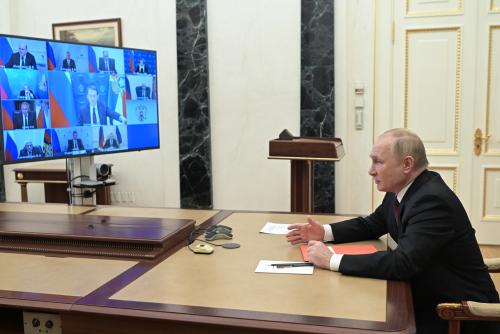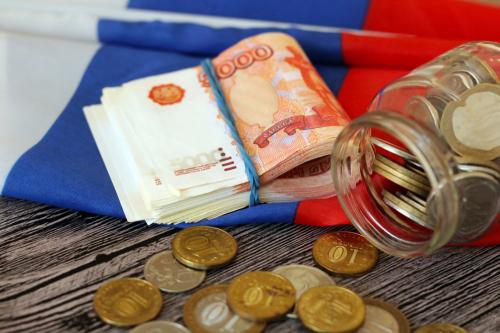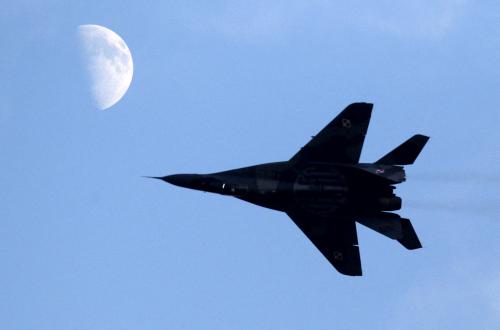With today’s update of the Brookings Sanctions Tracker, it is more clear than ever that Russia’s invasion of Ukraine has triggered a global response. Many of the world’s major democratic nations are engaging in economic warfare against Russia by implementing “the most comprehensive set of multilateral economic sanctions ever applied to a major global economy.”
America is helping lead the charge, exercising its unique power of controlling access to the dollar, effectively the world’s reserve currency. Understanding how the war is progressing is complicated enough given the asymmetric battlefields between physical and economic war.[1] It is further complicated as the conflict unfolds across three time horizons: the present, future, and the current expectations of the future. Understanding how these different time horizons affect dimensions of the conflict is critical to deciphering how the war is going and what lies ahead.
Let us begin with the present. The direct-armed conflict between Russia and Ukraine is happening in real-time with on the ground reporting providing a fluid but timely picture of developments. Generally speaking, Ukraine’s military has outperformed expectations, successfully slowing Russia’s invasion and inflicting greater damage on Russia’s military than anticipated. The result has been slower progress by Russian forces in securing territory and an expectation of a longer period of armed conflict.
The economic response that America and other major democracies have taken in response to Russia’s invasion is unfolding along two time periods: the present and future. Economic sanctions, the major tool used to weaken Russia’s economy, typically take time before their main impact is felt. Actual economic production is a lengthy process, as is the decoupling of global supply chains, access to financing, and international trade for final sale. While the speed, scope, and scale of the sanctions imposed on Russia are unprecedented, sanctions take some time to implement and have carve outs built in for pending contracts and deliveries to finish. Sanctions have more bite in sectors of the economy relying at some level on international trade and less impact on domestic activity. Russian airlines that use Boeing planes will find parts hard to find, eventually grounding even domestic travel, while barbershops will probably still be able to cut hair. However, banning future imports of goods does not mean they are no longer available as inventories are worked through.
Russia’s economy will surely suffer substantially, but not immediately. Ukraine’s surprisingly impressive ability to defend itself is lengthening the armed conflict, providing more time for the economic attack to have greater impact.
Sanctions are particularly effective in financial transactions given both the role of the U.S. dollar as the world reserve currency and the time horizon markets use, which include expectations of the future. Unlike actual economic impact, markets move instantly on both actions and expectations of future actions. Market expectations of Russia’s impending economic recession due to countermeasures have already sent Russian markets into a tailspin. Russia’s stock market was closed for nearly a month, and its reopening was correctly identified as a ‘potemkin’ show, not a real expression of the value of Russian assets. While Russia managed to avoid an actual default on its government debt with an interest payment in mid-March, it defaulted on its next payment in April as a result of U.S. sanctions. While the “ruble is no longer rubble,” from its sharp fall immediately after sanctions were announced, the rebound is the result of a set of capital controls, sky high interest rates, and carve outs in existing sanctions that can be tightened. Market confidence in the value of the ruble is so low that Russia itself is talking about conducting global trade using gold bars and Bitcoin rather than its own currency.
Financial markets are incorporating and translating future expectations of Russian economic weakness and the impact of continued decoupling from the global economic world order. Do not mistake financial markets indicating Russia’s economy is collapsing with actual collapse. Recall America’s financial markets went into free-fall in the third quarter of 2008 when the US economy was contracting by only 2.1%, after having grown at the same rate in the second quarter. What markets understood was that the actual collapse was coming, as fourth quarter GDP fell by a whopping 8.4%. Treasury Secretary Yellen is correct that Russia’s economy will be devastated as a result of the sanctions already put in place, but the emphasis is on ‘will be’ not ‘already is’.
Markets provide incredibly important information on economic conditions but can be moved substantially by expectations of future impacts. As a result, markets do not always reflect reality on the ground and should not be used as gauges for the immediate impact of the success of the economic war. Those who are hoping that the Russian people will begin to turn on Putin as a result of economic hardship have to appreciate the time frame involved in economic warfare.
Tracking the status of this war is highly complex due to the multiple battlefields and time horizons through which it is being waged. Russia’s physical invasion is proceeding slower than expected. This is particularly beneficial given the time required for America and its allies’ economic response. The financial bombs launched through kicking Russia out of the global payments system and decoupling it from broad swaths of international trade have already moved markets. Expect these actions to take far more time than markets to impact Russia’s means of economic production and the economic experiences of ordinary Russians. When assessing the progress of economic warfare, patience is important.
Footnote:
1. While this piece examines the military and economic dimensions of the conflict, there of course are many other “battlefields” involved, including digital attacks and other elements of cyber and information warfare. (Back to top)
-
Acknowledgements and disclosures
The author would like to thank Matthew Eitel and Kelly Kennedy for fact-checking assistance and Robin Lewis for editorial assistance on this piece.






Commentary
Multiple battlefields in time and space
April 29, 2022